Carl E. Olson's Blog, page 94
May 29, 2014
Because the Shepherds Need Joy: An Interview with Fr. Joseph Illo
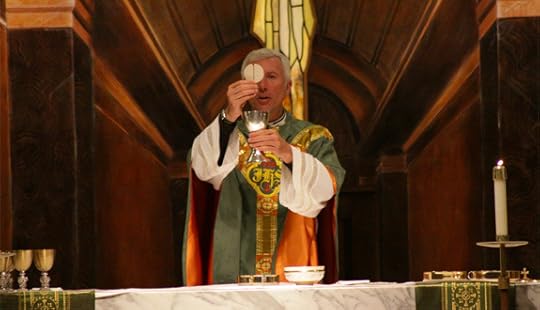
Fr. Joseph Illo celebrating Mass (Photo courtesy of Fr. Illo)
Because the Shepherds Need Joy | Jim Graves | CWR
Father Joseph Illo discusses plans to open the San Francisco Oratory of St. Philip Neri
Father Joseph Illo is planning to open the San Francisco Oratory of St. Philip Neri, an institute in the Catholic Church which allows “secular” parish priests the opportunity to live in community under a rule of life. The oratory was approved by San Francisco Archbishop Salvatore Cordileone, who welcomed the new community provided needed funds were raised. Fr. Illo requested $220,000 from followers of his blog (www.frilloblog.com); he has currently received 130 percent of his requested donation amount. The donations will cover living expenses until the community can become financially self-sustaining.
Fr. Illo was born in New York and grew up in New Jersey and Pennsylvania. He worked with Ignatius Press after graduating college, subsequently pursuing studies for the priesthood. He was ordained a priest for the Diocese of Stockton, California in 1991. His parish assignments include serving as pastor of St. Joseph Church in Modesto, California from 2000 to 2012.
Known for his outspoken fidelity to Catholic teaching, Fr. Illo made the news when he wrote his parishioners in 2008, “If you are one of the 54 percent of Catholics who voted for a pro-abortion candidate, you were clear on his position, and you knew the gravity of the question, I urge you to go to confession before receiving Communion.”
Since 2012, he has served as chaplain at Thomas Aquinas College in Santa Paula, California. Fr. Illo [pronounced I-low] recently spoke to Catholic World Report.
CWR: What made you want to become a priest?
Continue reading at www.CatholicWorldReport.com.
Three Brand New Ignatius Press Films, and Other Great Father's Day Gifts

This Father's Day,
give your dad a gift that is out of this world.
Choose one of our new films or spiritually enriching titles,
and touch not just his heart, but also his soul.
Save 20%* on featured titles
by entering the code FATHER at checkout.
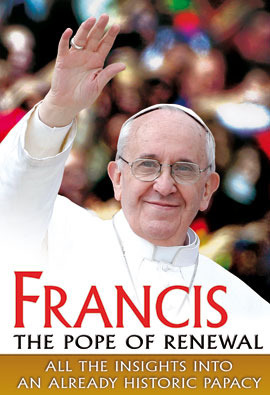
Francis: The Pope of Renewal
All the Insights into an Already Historic Papacy
This film shows the striking ascension to the top of world's popularity of the almost unknown Argentinian cardinal. It also reflects the renewal of the Catholic Church's image that he has generated. A brief street poll with people of various nationalities and beliefs suggests the extension of this phenomenon. What can be the causes of such spectacular change in the public opinion?
This documentary answers this and other questions.
53 minutes, $19.95
Watch the trailer
Learn More
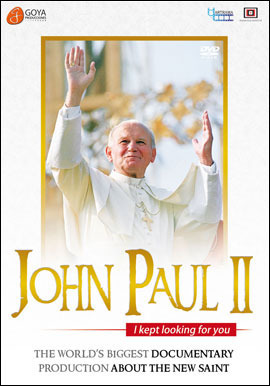
John Paul II: I Kept Looking for You
This new film is the world's biggest documentary on the new saint. It utilizes exclusive archival footage featuring John Paul II, as well as a lot of original shots made for this comprehensive film. Produced in HD quality, and four years in the making, it was filmed in 13 countries. It features many world famous figures from the Church, Politics, Entertainment and News industries, and their inspiring, insightful thoughts about and experiences with John Paul II.
90 minutes, $19.95
Watch the trailer
Learn More
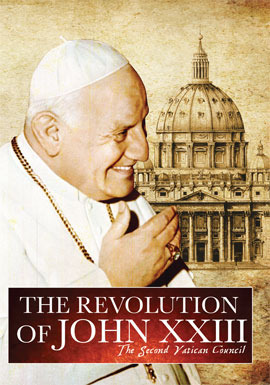
The Revolution of John XXIII
The Second Vatican Council
When he opened the historic Second Vatican Council in 1962, the "Good Pope" launched a spiritual revolution in the Church and the world. He summoned the bishops of the world to engage in straightforward discussions about the direction and future of the Church, and the relationship of the Church to the modern world. Few events in the history of the modern Catholic Church have been as far-reaching as the Second Vatican Council (1962-1965). And few have been as controversial.
55 minutes, $19.95
Watch the trailer
Learn More
More Great Titles for Dad
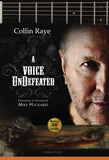
A Voice Undefeated
Collin Raye
$26.95
eBook and audio book on CD also available.
Read a sample chapter.
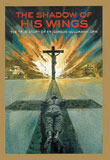
The Shadow
of His Wings
Fr. Gereon Goldmann
$17.95
eBook and audio book on CD also available.
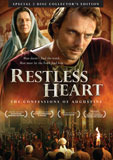
Restless Heart
DVD
$29.95
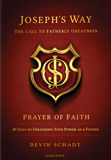
Joseph's Way: The Call to Fatherly Greatness
Devin Schadt
$16.95
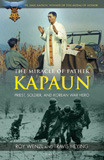
The Miracle of Father Kapaun
Roy Wenzl and Travis Heying
$19.95
eBook also available.
Related product:
The Miracle of Father Kapaun DVD
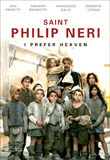
Saint Philip Neri
DVD
$24.95

The Father's Tale
A Novel
Michael O'Brien
$29.95
eBook and audio download also available.
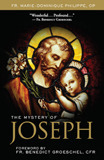
The Mystery of Joseph
Marie-Dominique Philippe
$14.95
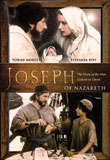
Joseph of Nazareth
DVD
$19.95
*This offer is valid online only from May 27, 2014 until June 2, 2014 midnight EST.
Copyright © 2014 Ignatius Press, All rights reserved.



Share

Tweet

Forward
The Ascension: Continuing Closeness and Source of Lasting Joy
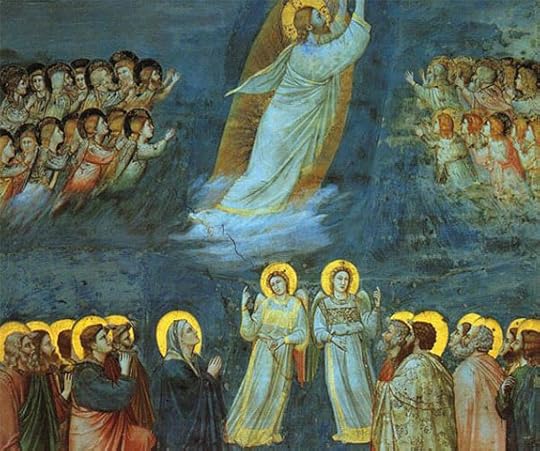
"The Ascension" (c. 1305) by Giotto di Bondone (Wikiart.org)
A Scriptural Reflection on the Readings for the Solemnity of the Ascension of the Lord | Carl E. Olson
Readings:
• Acts 1:1-11
• Psa 47:2-3, 6-7, 8-9
• Eph 1:17-23
• Matt 28:16-20
Pope Saint Leo the Great (c. 400-461), in a sermon on the Ascension, wrote, “Since then Christ's Ascension is our uplifting, and the hope of the Body is raised, whither the glory of the Head has gone before, let us exult, dearly-beloved, with worthy joy and delight in the loyal paying of thanks. For today not only are we confirmed as possessors of paradise, but have also in Christ penetrated the heights of heaven…”
Fifteen centuries later, in his second volume of Jesus of Nazareth (Ignatius, 2011), Pope Benedict XVI emphasized the central place of joy and delight in the Solemnity of the Ascension, stating, “The joy of the disciples after the ‘Ascension’ corrects our image of this event.”
What is need of correction? The notion that Jesus, by ascending into heaven, has gone away and is now somehow distant from mankind. But if that were true, Benedict pointed out, it doesn’t make sense of the “great joy” expressed by the disciples journeying to Emmaus after Jesus had blessed them, “parted from them and was taken up to heaven” (Lk. 24:51-53).
Nor would it explain why the disciples, having witnessed the ascension of Christ—as we hear in today’s first reading—immediately set about selecting a replacement for Judas (Acts 1:12-26). Rather than being depressed and listless, the disciples were filled with anticipation and a growing understanding of their mission. The opening of the Acts of the Apostles does not flinch from showing that the disciples, even after the Resurrection, were still coming to grips with the exact nature of Jesus’ intentions for the Church and for the world. Between his Resurrection and the his ascension, Jesus spent about forty days instructing the apostles, “speaking about the kingdom of God”. Yet they still asked, “Lord, are you at this time going to restore the kingdom to Israel?”
As Benedict noted, “Jesus counters this notion of a restored Davidic kingdom with a promise and a commission.” The promise is the gift of the Holy Spirit and of his own continual presence, as heard in the final words of Matthew’s Gospel: “And behold, I am with you always, until the end of the age.” This promise of the Holy Spirit was fulfilled in a most dramatic and definitive way at Pentecost. It is also fulfilled at every baptism and confirmation and celebration of the Eucharist, for all of the sacraments “are actions of the Holy Spirit at work in his Body, the Church” (Catechism of the Catholic Church, par 1116).
And it is fulfilled in other ways as well, for the Holy Spirit works tirelessly, through the proclamation the Word of God, through special charisms, and through the many hidden graces offered to us, if we are only willing to see and accept them.
The great commission, stated in both Acts 1 and Matthew 28, is clear and succinct: to be witnesses of Jesus Christ throughout the world, making disciples and baptizing them in the name of the Triune God. Jesus did not ascend into the presence of the Father to “get away” or to be silent, but so he can give himself continually and in perfect love to his bride, the Church. The Apostle Paul, in today’s reading from his letter to the Ephesians, pointed out that the risen Christ is “far above every principality, authority, power, and dominion”, having “put all things beneath his feet”.
But the Church, he said, is Christ’s body, “the fullness of the one who fills all things in every way.” Christ especially comes to us and fills us when we, members of his Mystical Body, receive the Eucharist, which expresses and communicate his love in a most profound way (cf. Catechism, par. 1380).
The Ascension, then, is both a going away and a coming. “‘Ascension’ does not mean departure into a remote region of the cosmos but, rather,” observed Benedict, “the continuing closeness that the disciples experience so strongly that it becomes a source of lasting joy.”
(This "Opening the Word" column originally appeared in the June 5, 2011, edition of Our Sunday Visitor newspaper.)
May 28, 2014
Enough Happy Talk—Let's Have Some Cross-Carrying Cheerfulness
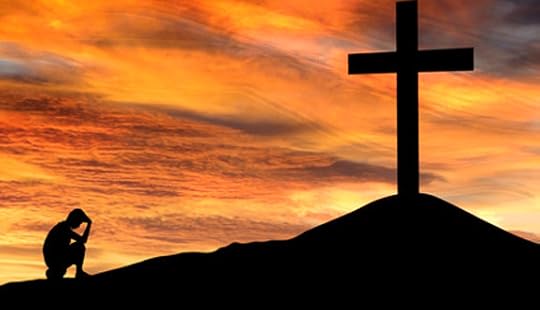
(© Creativa - Fotolia.com)
Enough Happy Talk—Let's Have Some Cross-Carrying Cheerfulness | Russell Shaw | Catholic World Report
Refusing to face facts isn’t genuine cheerfulness, it’s frivolity or denial
Call it happy talk, call it spin, call it the devil’s handiwork—you find cheerful blather just about everywhere today. In politics (tell the voters what they want to hear). In business (keep the stockholders happy, no matter what). In the military (gotta pump up the troops’ morale).
And even in the Church: “We don’t want to upset those people in the pews, do we?”
I read something recently by a fairly prominent churchman commenting on a finding that only 23% of American Catholics go to Mass every week but 77% say they’re proud to be Catholic. Good news, he enthused—“there is an openness among Catholics to be identified with the Church.”
Well, yes. But for many, it appears, not to the extent of taking part regularly in the central act of worship of that Church they say they’re proud to belong to.
Refusing to face facts isn’t genuine cheerfulness, it’s frivolity or denial. The only authentic kind of cheerfulness is the kind that starts by facing up to facts. In fact, I’d go so far as to say that the more in touch with reality someone is, the more cheerful he or she will be in the end.
Let me explain why.
Start with the distinction between two kinds of cheerfulness made by St. Josemaria Escriva. In his little book The Way the founder of Opus Dei writes:
The cheerfulness you should have is not the kind we might call physiological—like that of a healthy animal. Rather, it is the supernatural happiness that comes from the abandonment of everything, including yourself, into the loving arms of our Father God.
Indeed, there’s something downright offensive about this “physiological’ cheerfulness. I think that’s what Dietrich Von Hildebrand is talking about when he speaks in Transformation in Christ of what he calls “joviality”:
May 27, 2014
Fr. Robert Barron on Hans Urs von Balthasar (Part 2 of 2)
In the second of two videos on the life and work of Fr. Hans Urs von Balthasar (here is the first video), Fr. Barron looks at some of the major themes in von Balthasar's work, including thoughts on the hope that all will be saved:
Why Is Gay Not Okay?
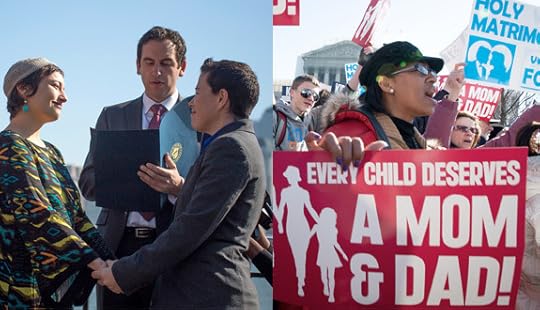
Left: Meredith Greenberg holds hands with her partner, Leora Pearlman, as Mayor Steven Fulop of Jersey City, N.J., presides over their wedding in Jersey City Oct. 21, 2013. (CNS photo/Shannon Stapleton, Reuters). Right: People demonstrate outside the Supreme Court building in Washington in this photo from late March 2013, when the court heard oral arguments in two same-sex marriage cases. (CNS photo/Nancy Phelan Wiechec)
Why Is Gay Not Okay? | Carl E. Olson | Catholic World Report
“Compassion does not trump truth,” says Robert R. Reilly, “And the truth is becoming harder to tell.”
Scholar and author Robert R. Reilly was Senior Advisor for Information Strategy (2002-2006) for the U.S. Secretary of Defense, after which he taught at National Defense University. He was the director of the Voice of America from 2001 to 2002, and served in the White House as a Special Assistant to the President from 1983 to 1985. He is a graduate of Georgetown University and the Claremont Graduate University, and has written widely on “war of ideas" issues, foreign policy, and classical music. His previous books and monographs include Surprised by Beauty: A Listener's Guide to the Recovery of Modern Music, The Closing of the Muslim Mind: How Intellectual Suicide Created the Modern Islamist Crisis, and The Prospects and Perils of Catholic-Muslim Dialogue.
His new book, Making Gay Okay: How Rationalizing Homosexual Behavior Is Changing Everything, was published recently by Ignatius Press. It has been praised as “magnificent, a real achievement” (Austin Ruse, President, Catholic Family and Human Rights Institute) and described as “a rare tour de force on a defining question of our time” (Dr. Robert Royal, President, Faith & Reason Institute). Reilly recently corresponded with Carl E. Olson, editor of Catholic World Report, about his new book and its approach and arguments.
CWR: Right at the start, you make the connection between contraception and same-sex marriage, writing in the Introduction that the “progression from the one to the other was logically inescapable.” What are the main points of that progression? How unique is the “capstone” of same-sex marriage; that is, how uncharted are the waters that have now flooded society?
Reilly: The key is separating sex from diapers. Once you consciously subvert the procreative power of sex with contraception, there is a very slippery slope—more like a cliff, actually—down to the moral pigpen where sex is simply a form of degraded entertainment. You try to grab the pleasure from the act, while denying the thing toward which the act is essentially ordered.
So it is perfectly logical to go from contraception to abortion (so those whose contraception has failed are not “penalized”) to the celebration of sodomy as the basis of marriage. Homosexuals can easily pose the question, “if you endorse contracepted heterosexual acts, what could possibly be wrong with our acts which don’t even have to be contracepted?”
The logic of the situation makes it very easy to see where this is going next—polygamy and polyandry. In fact, a Federal District Court has already taken a step in this direction in respect to Utah’s laws against polygamy. When we allow homosexual acts to serve as the basis for “marriage,” anything goes.
CWR: Your thesis, as you noted, “is very simple: There are two fundamental views of reality.” What are those two views of reality? And if the thesis is simple, why is it so difficult for people to either comprehend it or to explain it themselves?
Continue reading at www.CatholicWorldReport.com.
Related articles
 New: "The Seven Big Myths about Marriage" by Christopher Kaczor
New: "The Seven Big Myths about Marriage" by Christopher Kaczor The Introduction to "Making Gay Okay" by Robert R. Reilly
The Introduction to "Making Gay Okay" by Robert R. Reilly Welcome to The Reign of "Gay"
Welcome to The Reign of "Gay" Why the Gays are Winning
Why the Gays are Winning
May 26, 2014
Eschatology and Eucharistic Adoration
Eschatology and Eucharistic Adoration | Christopher J. Malloy | HPR
In this article, I aim to establish a credible link between the promising aspects of contemporary eschatological theory and the simple practice of adoration.
Early in his pontificate, Pope Benedict XVI called for the spread of perpetual Eucharistic adoration (March 2, 2006). Leading by example, Pope Francis, early in his pontificate, called for people everywhere to join him in Eucharistic adoration on the Feast of Corpus Christi, June 2, 2013. Our Holy Fathers have been following in the steps of their predecessor, John Paul II. Due in large part to the latter’s efforts, Eucharistic adoration spread like wildfire in the 1990s and has only increased since.
By contrast, certain “liturgists” and “theologians” insist on deriding this pious devotion. They stamp it mere “private devotion.” In fact, in its complete form, from exposition to benediction, it is a liturgical event. At any rate, it has a long, and shall enjoy an everlasting, approval in the Church. Despite this, professional liturgists have called it “cookie worship.” True, if the Eucharist were only a sign, however “dense,” it would be idolatry to worship it.
Similarly, a number of contemporary Catholic theologians also deride the “traditional” view of eschatology. According to this “traditional” view of eschatology, which they deride as “apocalypticism,” there will be such things as end-of-world calamities, a final collective judgment, resurrection from the dust of the ground, and everlasting torment in hell for the damned. Such things are, some theologians maintain, fable-like pictures meant to encourage less educated Christians to conduct themselves rightly. Some go as far as to deny that there is an “eternal hell.” Others maintain that hell does not include the so-called “pain of sense,” that is, bodily and psychic pains executed by God in just retribution for crimes committed by unrepentant sinners during their earthly lives. Others maintain that hell is only a remote possibility. Others deny that God has ordained an “end” of history. These traditional elements of eschatology are, so it is said, mythical modes of thought intended simply to encourage every individual to contemplate the seriousness of life in the face of being “thrown towards death.” In short, Jesus’ message, Paul’s message, and Isaiah’s message, are being “demythologized,” interpreted simply as morally powerful and useful tales. Although demythologization came to reign no short time ago, it still has a wide following.
I have indicated two elements of “traditional” Catholicism that are not infrequently derided by contemporary “academics.” As I hope to show, the derision of each element is related to that of the other. This is not to say that any theologian who derides the one will deride the other; it is to say, however, that the divine-human fabric connecting these two elements together makes the derision of one objectively inseparable from that of the other.
Notwithstanding the pitfalls of demythologization of eschatological truths and of irritation with Eucharistic adoration, there lie in the contemporary articulations of eschatology and in contemporary sacramental theory most significant grains of truth. Chief among these truths is the fact that our entire existence is “suspended” between our coming from the Father of lights (Jas 1:17) and our returning thence through death. Thus, in this veil of tears, we discover the truth only through its mediations; no man has seen God, and the face of Jesus Christ, though discernible, yet eludes us, beckons us on. We exist, indeed, “towards death,” yet in Christian hope, we know that we are “towards the Father,” and to some extent we experience even our haplessness in this way. There is cause for fear and sadness and cause for joyful trust.
In this article, I aim to establish a credible link between the promising aspects of contemporary eschatological theory and the simple practice of adoration. I take as my leitmotiv the eschatological conception of Christianity as a “way,” a movement drawn to the Father through the “Way” (Jn 14:6). I will draw throughout on the teachings of Pope Benedict XVI.
On the surface, it seems that adoration and eschatology have nothing in common.
The Longest Battle
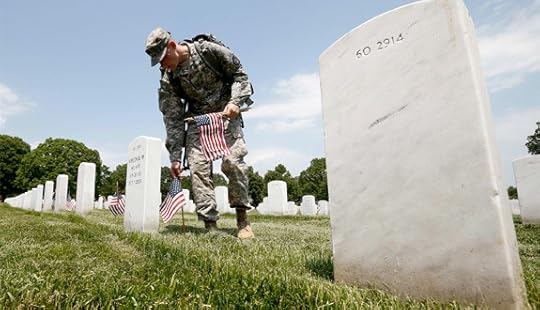
A member of the Third U.S. Infantry Regiment places flags on graves in Section 60 during a "Flags-In" ceremony May 22 at Arlington National Cemetery near Washington. The soldiers placed American flags in front of more than 220,000 graves. (CNS photo/Kevin Lamarque, Reuters)
The Longest Battle | John Burger | CWR
Veterans struggle in aftermath of recent wars, but friendship and structures of faith help the process of healing
Post-traumatic stress. Amputations and brain injuries. High suicide rates. Can any good news come out of the Iraq and Afghanistan wars?
The effects of our recent military engagements in the Middle East are long-lasting. Though today’s veterans come home to a friendlier reception than their Vietnam-era forebears had, thousands of men and women who served in Operation Enduring Freedom and Operation Iraqi Freedom carry scars physical, mental, emotional, and spiritual that are deep and abiding.
Will they recover? Can they recover? What can be done for them? Is the Veterans Affairs (VA) system adequate? Is spiritual help being offered for those who need it? What difference is it making?
As America celebrates another Memorial Day and Congress questions whether the VA system of medical centers is doing enough, the veterans who have served this country continue to fight a battle—often a tough one—to reintegrate into “normal” American life.
The Unseen War
According to some, problems like post-traumatic stress disorder (PTSD) and suicide among veterans have gone through the roof.USA Today reported that 50,000 new veterans were diagnosed with PTSD during 2012. That figure reflects little progress over the previous four years: a 2008 RAND Corporationstudy estimated that approximately 20 percent of returning active duty troops—about 300,000 of the 1.64 million who served in the recent wars—suffer from PTSD, accompanied by major depression.
Suicide is another issue.
May 24, 2014
The most mysterious and enigmatic Person in the Bible
A Scriptural Reflection on the Readings for May 25, 2014, the Sixth Sunday of Easter
Readings:
• Acts 8:4-8, 14-17
• Psa 66:1-3, 4-5, 6-7, 16, 20
• 1 Pet 3:15-18
• Jn 14:15-21
How would you answer this question: “Who do you think is the most mysterious and enigmatic person in the Bible”?
There are a lot of great answers. Here is mine: the Holy Spirit.
The Holy Spirit is indeed mysterious, even somewhat nebulous, and I sometimes wonder if there isn’t a temptation to sometimes think less of him or less about him than of the Father or the Son. But, of course, the Holy Spirit is as fully and completely God as the Father and the Son. He is identified in the New Testament with titles such as Paraclete, the Spirit of adoption, the Spirit of the Lord, and the Spirit of glory (see Catechism of the Catholic Church, par. 692-3). He is represented by or associated with many symbols, including water, oil of anointing, fire, clouds and light, and a dove.
Today’s readings, which turn us even more deliberately toward Pentecost, speak of the Holy Spirit in relation to the sacraments, divine life, and truth.
At first glance, the story of Philip is a perplexing one. Philip, one of the seven men chosen and ordained as a deacon by the apostles (Acts 6:5), was preaching among the Samaritans, to the north of Judea. Having performed signs, including the exorcism of unclean spirits, he apparently baptized many of the people who had “accepted the word of God”. But it wasn’t until Peter and John, who arrived afterward, prayed over and laid hands upon the converts that they “received the Holy Spirit”.
It’s not that Philip’s work was unworthy or faulty; on the contrary, his labors had prepared the way for the apostolic blessing given by Peter and John, who validated and completed—by and through the sanctifying power of the Holy Spirit—the sacramental work already begun. The Holy Spirit, who is the soul of the Church, unifies and directs the Apostles, their successors, and the members of the Mystical Body of Christ (see Catechism, pars. 797-8).
Peter’s statement about Christ’s death is also difficult and has been the source of much discussion among theologians and exegetes: “Put to death in the flesh, he was brought to life in the spirit. In it he also went to preach to the spirits in prison…” (1 Pet 3:18-19). The identity of these imprisoned spirits is not completely clear; they may have been those who perished in the Noahic flood or fallen angels whose rebellion against God was associated in Jewish tradition with that same flood. Regardless, we see that the Holy Spirit gives life, and this is why Peter further states, “This prefigured baptism, which saves you now…” (1 Pet 3:21).
The work of the Holy Spirit in the giving of divine life is fundamental, revealed by Jesus when he told Nicodemus, “Amen, amen, I say to you, no one can enter the kingdom of God without being born of water and Spirit” (Jn 3:5). This new birth is entrance into communion with God, for as the Apostle Paul wrote, “in one Spirit we were all baptized into one body, whether Jews or Greeks, slaves or free persons, and we were all given to drink of one Spirit” (1 Cor 12:13).
Jesus, in his last great discourse in the Gospel of John, promised his disciples a gift: another Advocate (or Paraclete), “the Spirit of truth”. Just as the Father shows his love by sending the Son, so the Son shows his love by sending the Spirit. St. Thomas Aquinas wrote, “What is first given is love; that is the first gift. The Holy Ghost comes forth as the substance of love, and Gift is his proper name” (Summa Theologica, I, 38, 2). The Byzantine churches have a great hymn that expresses these truths most beautifully:
“Heavenly King, Comforter, Spirit of Truth, who are everywhere present and fill all things, Treasury of Blessings and Giver of Life, come and dwell within us, cleanse us of all stains, and save our souls, O Gracious Lord. Amen.”
(This "Opening the Word" column was originally published in the May 29, 2011, edition of Our Sunday Visitor newspaper.)
On the Eve of Francis and Bartholomew’s Embrace
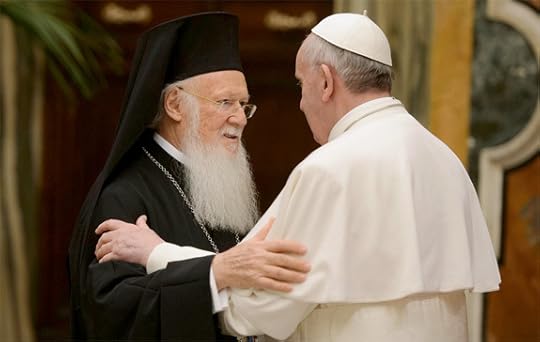
Pope Francis embraces Ecumenical Patriarch Bartholomew of Constantinople, spiritual leader of Orthodox Christians, at the Vatican March 2013. (CNS photo/L'Osservatore Romano via Reuters)
On the Eve of Francis and Bartholomew’s Embrace | Christopher B. Warner | CWR blog
Seven cataphatic, or positive, points about the meeting between the Pope and the Patriarch
Pope Francis and Ecumenical Patriarch Bartholomew will meet in Bethlehem, Sunday evening, and then pray together in an ecumenical prayer service at the Holy Sepulcher. The events of the weekend can be followed through the official website, Pope Francis in the Holy Land 2014. Let us pray together with Francis, Bartholomew, and the many Christian leaders meeting with them in the Holy Land for authentic unity in Christ.
I hope you had a chance to read Dr. Adam A.J. DeVille’s analysis of current ecumenism. The following seven cataphatic (positive) points are offered here as a compliment to his article. They summarize some of my own thoughts on this momentous occasion:
1. The Embrace: Let us not underestimate the sign of fraternal charity between Francis and Bartholomew on this very significant historical occasion. Fifty years ago, Pope Paul VI and Ecumenical Patriarch Athenagoras likewise embraced in Jerusalem, lifted the century old anathemas, and began modern Orthodox-Catholic dialogue as we now know it.
2. Progress in Dialogue: A lot of ground has been covered in the Orthodox-Catholic dialogue. The titles of joint documentsproduced by the North American Orthodox-Catholic Theological Consultation demonstrates how many dividing issues have been wrestled with and how much work has been done. The embrace of Paul VI and Athanagoras was far more than just a nice gesture in a geo-political game. Let us pray that the next fifty years will mark significantly more cooperation and integration between Orthodox and Catholic Christians.
As Dr. DeVille suggests, Eucharistic inter-communion between Orthodox and Catholic churches someday may again be possible and should be ardently prayed for. But Eucharistic communion presupposes theological and canonical harmony. We are getting closer to that goal, but we are still a long way away.
3. Uniatism is a Blessing, not Curse:
Carl E. Olson's Blog
- Carl E. Olson's profile
- 20 followers




